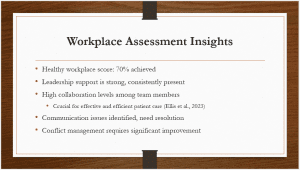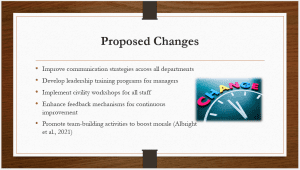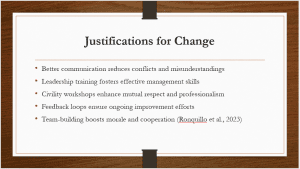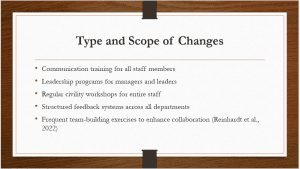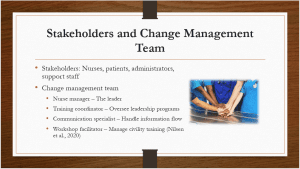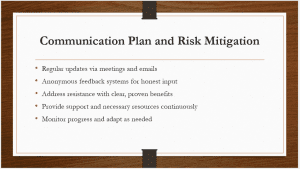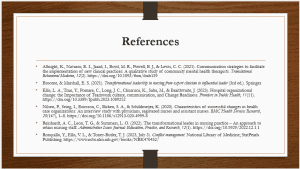Change Implementation and Management Plan
Welcome to this presentation on transformational leadership in nursing. Today, we will explore how nurses transition from being expert clinicians to influential leaders. This presentation will draw on various insights from recent workplace assessments and change management plans.
The current issues in our organization are significant and require immediate attention. Notably, the Workplace Environment Assessment indicated a moderately healthy environment but with substantial room for improvement. The current workplace is affected by issues such as poor communication and ineffective conflict management. These problems lead to misunderstandings, reduce efficiency, and negatively impact team morale, ultimately affecting the quality of patient care. Poor communication results in errors and a lack of trust among staff members, while unresolved conflicts create a hostile work atmosphere that hinders productivity and job satisfaction.
Further, the organization currently lacks consistent, effective leadership to address these problems and guide the team through necessary changes. Effective leadership, particularly transformational leadership, is vital as it focuses on inspiring and engaging employees, building strong team relationships, and driving continuous improvement. Transformational leaders create a positive, collaborative environment, improving teamwork and patient outcomes (Broome & Marshall, 2021). Continuous improvement, emphasized in the Change Implementation and Management Plan, is critical for maintaining and enhancing workplace health and performance through regular training, feedback mechanisms, and team-building activities (Broome & Marshall, 2021).
A recent workplace assessment revealed a healthy workplace score of 70%, meaning that our workplace is moderately healthy, but there is room for development. A positive perspective is that the leadership has always been and remains highly supportive, which is essential for maintaining motivation and providing proper direction. Furthermore, the assessment revealed that team members worked cooperatively most of the time, which is crucial for effective and efficient patient care and meeting a healthcare facility’s objectives (Ellis et al., 2023).
Nevertheless, some problems in communication were observed, and they caused confusion and mistakes. It is important to overcome these issues in order to make the working environment more integrated. Another emerging common theme was the need to enhance conflict management. It is, therefore, important to establish proper ways of handling conflicts to avoid escalation and ensure a healthy working environment. Addressing these insights will help improve the workplace environment and staff and patient outcomes.
To tackle the aforementioned problems, communication in the organization should be enhanced from department to department, which would eliminate conflict and disparity in the working environment among the different departments. Leadership training courses for managers are important to establish as good leadership helps improve organizational performance and charges employees with positive energy, hence improving job satisfaction ratings. Moreover, establishing training programs for conduct and courtesy for all employees will help foster humane and proper attitudes as foundations for a healthy organizational climate.
Improving feedback channels will also guarantee improvement by creating an avenue where the staff can highlight their complaints and recommend action to the management. Encouraging staff to engage in more team-related activities will enhance group cohesion and, therefore, the quality of care and organizational performance. Thus, through the proposed changes, the organization can achieve a healthier workforce whose productivity will enhance the treatment of patients.
Conflict resolution in organizations is effectively resolved with proper communication since it leads to minimal disagreements. Management training creates effective managers as it prepares candidates to be able to effectively manage employees or a specific department. Realizing civility workshops improve conduct and courtesy in relations between individuals and make the workplace environment positive and civil.
Similarly, feedback loops promote the continuation of improvement processes since they allow for the cycling of evaluations and improvements in accordance with the staff’s feedback. Team-building activities increase group cohesion and productivity by enhancing unity among the teams. These arguments pinpoint the significance of each change that has been put forward regarding present-day problems in the workplace and creating a positive working environment and productivity (Ronquillo et al., 2023).
Some of the changes that have been suggested include the need to undertake training for all the staff in the area of communication to eliminate incidences of communication breakdown. Management courses for managers and leaders are crucial to enhancing management skills and assisting in team direction. This would be done by organizing civil-interactive workshops for all personnel to enhance workplace professionalism and respect for each other (Reinhardt et al., 2022).
Across the departments, there will be a structured feedback system that will enhance constant improvement by providing feedback from the staff. Regular teaming activities will improve the working relationship between members, resulting in improved teamwork and quality patient care. These changes are systemic and affect various aspects of the workplace to foster a positive and effective organizational culture.
Stakeholders affected by these changes are nurses, patients, administrators, and support personnel, all of whom are affected by the workplace climate and its enhancement. The change management team will consist of a nurse manager in charge of implementing the process and ensuring that the changes to be made align with the organization’s goals. The training coordinator will be responsible for leadership training, ensuring that managers and leaders are trained to steer their teams.
To ensure that information dissemination and feedback channels are well communicated within the organization, the communication specialist will be responsible for disseminating the updates and feedback mechanisms. Civility training will be implemented by the workshop facilitator, who will arrange workshops frequently to maintain courtesy and appropriate etiquette among the staff. This team structure guarantees that all changes are handled in the most efficient, successful manner, including the proposed changes (Nilsen et al., 2020).
The implementation of the communication plan will include weekly meetings and email communication to ensure that all the staff members are aware of the changes and the progress made. Issues of the welfare of the staff will be addressed by providing an environment where they are free to give their opinions through anonymous feedback systems. Overcoming resistance will be a major concern and can be addressed by providing information on benefits that are easy to associate with the changes.
The staff requirement is to have adequate and sustained support to equip them with what they need to embrace the new initiatives effectively. Constant checking of progress and forward adjustments will ensure that any problem has been detected and addressed before hampering the effectiveness of the implementation process. Practical communication and risk management strategy will aid in achieving the intended change, hence enhancing the workplace environment.
The anticipated benefits of these changes include increased courtesy and civility in workplace relations and a positive, supportive climate for all employees. Patients and caregivers will benefit from improved communication and a stronger bond within the team to improve care delivery. Positive changes in the staff working environment also mean enhanced staff satisfaction due to better staff support systems. This will result in high morale and, therefore, low organizational turnover rates. Improved patient outcomes and care quality are expected due to increased synergy and satisfaction of staff members. Lastly, effective leadership and management practices will be created to ensure that the change is continued in the future. Collectively, these outcomes will result in a healthier, more productive, and hence more positive workplace.
Albright, K., Navarro, E. I., Jarad, I., Boyd, M. R., Powell, B. J., & Lewis, C. C. (2021). Communication strategies to facilitate the implementation of new clinical practices: A qualitative study of community mental health therapists. Translational Behavioral Medicine, 12(2). https://doi.org/10.1093/tbm/ibab139
Broome, & Marshall, E. S. (2021). Transformational leadership in nursing from expert clinician to influential leader (3rd ed.). Springer
Ellis, L. A., Tran, Y., Pomare, C., Long, J. C., Churruca, K., Saba, M., & Braithwaite, J. (2023). Hospital organizational change: the Importance of Teamwork culture, communication, and Change Readiness. Frontiers in Public Health, 11(11). https://doi.org/10.3389/fpubh.2023.1089252
Nilsen, P., Seing, I., Ericsson, C., Birken, S. A., & Schildmeijer, K. (2020). Characteristics of successful changes in health care organizations: An interview study with physicians, registered nurses and assistant nurses. BMC Health Services Research, 20(147), 1–8. https://doi.org/10.1186/s12913-020-4999-8
Reinhardt, A. C., Leon, T. G., & Summers, L. O. (2022). The transformational leader in nursing practice – An approach to retain nursing staff. Administrative Issues Journal: Education, Practice, and Research, 12(1). https://doi.org/10.5929/2022.12.1.1
Ronquillo, Y., Ellis, V. L., & Toney-Butler, T. J. (2023, July 3). Conflict management. National Library of Medicine; StatPearls Publishing. https://www.ncbi.nlm.nih.gov/books/NBK470432/
ORDER A PLAGIARISM-FREE PAPER HERE
We’ll write everything from scratch
Question
It is one of the most cliché of clichés, but it nevertheless rings true: The only constant is change. As a nursing professional, you are no doubt aware that success in the healthcare field requires the ability to adapt to change, as the pace of change in healthcare may be without rival.
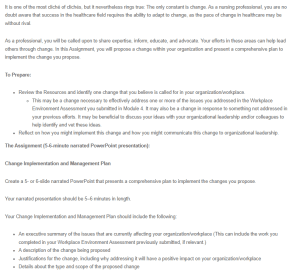
Change Implementation and Management Plan
As a professional, you will be called upon to share expertise, inform, educate, and advocate. Your efforts in these areas can help lead others through change. In this Assignment, you will propose a change within your organization and present a comprehensive plan to implement the change you propose.
To Prepare:
- Review the Resources and identify one change that you believe is called for in your organization/workplace.
- This may be a change necessary to effectively address one or more of the issues you addressed in the Workplace Environment Assessment you submitted in Module 4. It may also be a change in response to something not addressed in your previous efforts. It may be beneficial to discuss your ideas with your organizational leadership and/or colleagues to help identify and vet these ideas.
- Reflect on how you might implement this change and how you might communicate this change to organizational leadership.
The Assignment (5-6-minute narrated PowerPoint presentation):
Change Implementation and Management Plan
Create a 5- or 6-slide narrated PowerPoint that presents a comprehensive plan to implement the changes you propose.
Your narrated presentation should be 5–6 minutes in length.
Your Change Implementation and Management Plan should include the following:
- An executive summary of the issues that are currently affecting your organization/workplace (This can include the work you completed in your Workplace Environment Assessment previously submitted, if relevant.)
- A description of the change being proposed
- Justifications for the change, including why addressing it will have a positive impact on your organization/workplace
- Details about the type and scope of the proposed change
- Identification of the stakeholders impacted by the change
- Identification of a change management team (by title/role)
- A plan for communicating the change you propose
- A description of risk mitigation plans you would recommend to address the risks anticipated by the change you propose
- Broome, M., & Marshall, E. S. (2021). Transformational leadership in nursing: From expert clinician to influential leader (3rd ed.). New York, NY: Springer.
- Chapter 4, “Practice Model Design, Implementation, and Evaluation” (pp. 99–154)
- Boustani, M., Azar, J., & Solid, C. A. (2020). Agile implementation: A model for implementing evidence-based healthcare solutions into real-world practice to achieve sustainable changeLinks to an external site.. Morgan James Publishing.
- Campbell, R. J. (2020). Change management in health careLinks to an external site.. Health Care Manager, 39(2), 50–65.
- National Institute of HealthLinks to an external site.. (n.d.). https://www.nih.gov/health-information
- Reinhardt, A. C., Leon, T. G., & Summers, L. O. (2022). The transformational leader in nursing practice — An approach to retain nursing staffLinks to an external site.. Administrative Issues Journal: Education, Practice, and Research, 12(1), 1–12. https://doi.org/10.5929/2022.12.1.1



